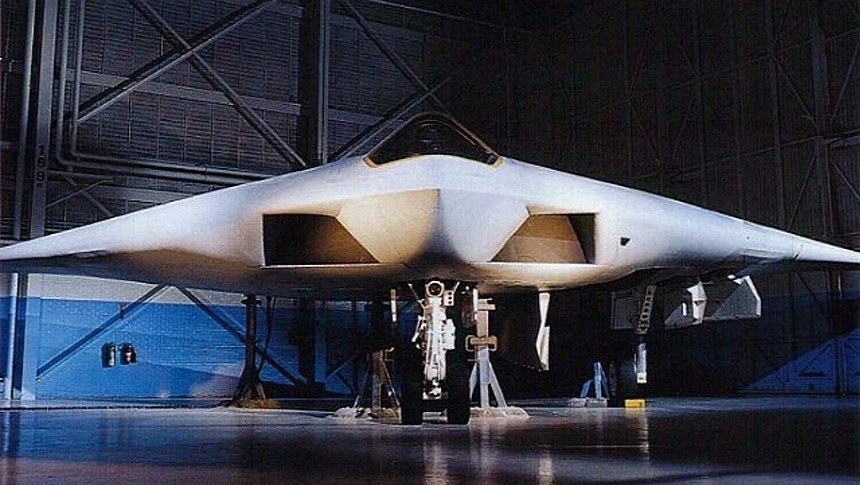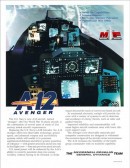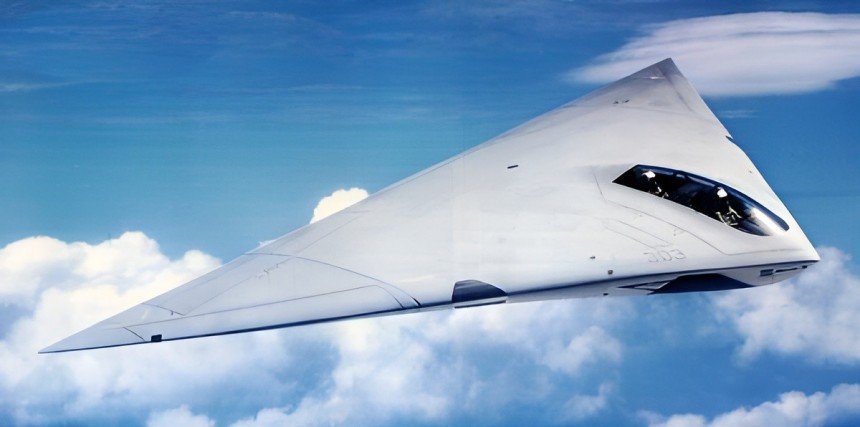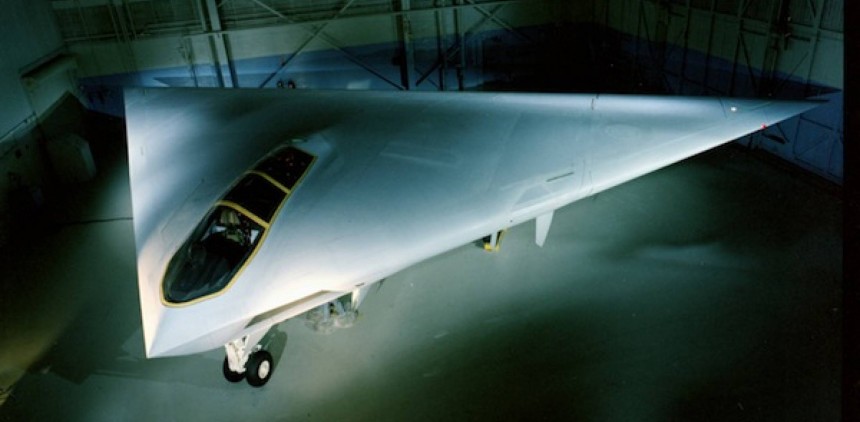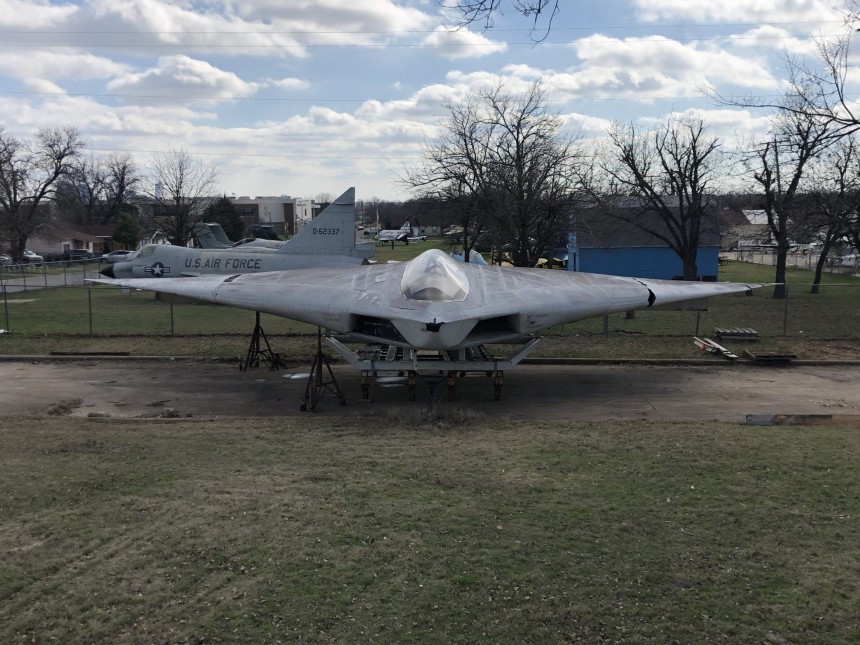The sibling rivalry between the U.S. Air Force and the U.S. Navy is, in many ways, similar to something you'd see on an old Nickelodeon sitcom; most of a certain age know which one. When one sibling gets a toy, the other one inevitably wails and cries until they get a similar shiny doohickey too. So when the Air Force was blessed with the world's first military jet capable of radar stealth in the early 1980s, the Navy, rather than throwing a screaming tantrum, started the quest for their own equivalent.
Based on the fact the McDonnell Douglas/General Dynamics A-12 Avenger II isn't sailing aboard Navy aircraft carriers at the moment, the Navy's first attempt at a stealth jet didn't pan out the way they'd hoped. In fact, it only made the contractors involved several hundred million dollars less wealthy. The story behind it all showcases all that's terrible about the military-industrial complex. From farm to table, or blueprints to mockup in this case, the A-12 program was a wall-to-wall catastrophe that wasn't resolved for more than three decades post the program's initiation. Yup, it's one of those classic military-industrial snafus that litigation lawyers like to drool over, only wishing they could've taken the case.
As mentioned above, it was the Air Force, through a partnership with the legendary Lockheed Corporation of California, who laid claim to the first radar stealth-capable military jet, the F-117 Nighthawk. Of course, the Nighthawk carried neither air-to-air missiles nor a cannon, so the F designation at the beginning of its name was placed more to scare the daylights out of enemy combatants than to signify the arrival of the first dedicated stealth fighter. Whatever the case, the Navy introduced a program to develop a carrier-oriented response to the F-117 in October 1983, the same year the Nighthawk was introduced to operational service.
Dubbed the Advanced Tactical Aircraft (ATA), two separate teams of American aerospace contractors submitted proposals as per the Navy's request. On one side was a team of carrier jet heavyweights in the form of Northrop and Grumman before their merger into Northrop Grumman, as well as Vaught. The second group was the fearsome tag team of McDonnell Douglas and General Dynamics, makers of the F-15 Eagle and the F-16 Fighting Falcon, respectively. For the next six years, the two teams spent countless thousands of man-hours toiling away at the blueprints for the world's first carrier-bound stealthy attack jet.
Though Northrop, Grumman, and Vought may have had more experience building carrier aircraft, the U.S. Navy soon became enamored with McDonnell Douglass and General Dynamic's proposal. A proverbial UFO of a design, MD and GD's twin-engine submission for the ATA program earned every bit of its nickname, the "Flying Dorito." If real life were a kid's cartoon, you could pluck the A-12 out of the sky and dip it in some spicy queso. Jokes aside, the Navy opted for General Dynamics-ran operation to build their first stealth jet in January 1988. The name "Avenger II" stems from the TBF Avenger torpedo bomber of World War II fame.
Ironically, the original Avenger was built by Grumman, a member of the enemy design team. What a wacky coincidence. With projected dimensions of 37 feet and ten inches (11.5 m) long and a 70-foot, three-inch (21.4-m) wingspan, the A-12 was built to take up only marginally more space on the deck of an American carrier as the already operational F-14 Tomcat or A6 Intruder. Sporting folding wings like most carrier jets to maximize space inside the hangar, the A-12 took all the traditions of Navy-specific jets and brought them kicking and screaming into a projected 21st century. In fairness, these projections weren't far off from reality.
Had it actually flown, the A-12 was set to carry two General Electric F412 non-afterburning turbojet engines producing at least 13,000 lbs (58 kN) of thrust each. This engine still powers a plethora of different fighter airframes in its day, including McDonnell Douglas' own F-18 Hornet and the Indian HAL Tejas delta-wing fighter. As for armament, the A-12 was considerably less useless in air-to-air engagements than its land-based cousin in the Air Force, the F-117. Unlike the Nighthawk, the Avenger II was slated to carry up to two AIM-120 AMRAAM long-range, air-to-air missiles, one in either of two secondary weapons bays on either side of the main underwing bomb bay.
Inside the main bomb bay sat the Avenger II's mission objective ordinance, primarily the then brand-new Texas Instruments AGM-88 anti-radiation missile developed specifically for knocking out enemy radar installations. Even almost 40 years later, this weapon is still being used as we speak against anti-Russian forces in Ukraine. Additionally, the A-12 could have carried an unspecified load of both unguided and guided bombs like the Mark 82 or the GBU-12 Paveway II. Sadly, the Avenger II carried no cannon, a flaw which counted ditto for the F-117 Nighthawk.
On paper, the Navy had a jet that fulfilled everything it hoped for. In 1996, a full-scale mockup of the novel jet was even put on display at the Naval Air Station Joint Reserve Base Fort Worth, and it's claimed even the Marines and Air Force were interested in placing an order. But weirdly, by the time any old civilian had heard of, let alone seen the Avenger II with their own eyes, the entire A-12 program had already been canceled. Little did most common av-geeks know at the time, but the supposedly "dynamic" duo of McDonnell Douglas and General Dynamics had long since run afoul of the one man they needed to keep happy. That man was the then U.S. Secretary of Defense and future Vice President Dick Cheney.
At one time a massive proponent of the A-12 initiative, Secretary Cheney soon grew into something of a disappointed father character as he presided over years of seemingly endless cost overruns and deadline misses the public knew absolutely nothing about. To add to the woes, engineering redesigns to the original A-12 blueprints had been modified to make the gross weight of the airframe nearly 30 percent over what was initially projected. Though not a fighter pilot himself like his colleague John McCain, these red flags were enough to make Secretary Cheney ask the Navy point blank why the languishing project shouldn't be canceled.
Evidently, The Avenger II team could have done a better job with their retort, as the program was formally canceled just a month after Cheney's declaration in January 1991. But General Dynamics and McDonnell Douglas wouldn't go quietly into the night. Or, more accurately, their lawyers wouldn't. Thus began a legal battle between the Department of Defense and the A-12's two primary contractors. Unsurprisingly for such a high-stakes lawsuit, the case made its way through the U.S. Federal Circuit Court and all the way to the Supreme Court, the highest office in the land. At least at first, the U.S. Court of Federal Claims appeared to side with the Avenger II team.
Ultimately, a little-known legal clause known as the State Secrets Privilege forbade General Dynamics or McDonnel Douglas' legal team from mounting a defense that could dispel highly classified military secrets. Undoubtedly a major bummer for the non-government-backed side of this legal skirmish. But, with the post-Soviet Russians, Chinese, and Iranians snooping around where they shouldn't be at that time, it does at least make sense why such a result would occur. In the end, it'd take a truly astonishing amount of time for both sides to come to an agreement.
In January 2014, over 30 years after the start of the Advanced Tactical Aircraft program, both McDonnell Douglas and General Dynamics were ordered to pay a fine of $400 million split evenly between both parties for supposedly way overpromising the DOD in terms of what they could deliver with the Avenger II program. By this time, both companies had long been absorbed into larger aerospace companies like Lockheed Martin and Boeing. It stands to reason it was the parent companies who had to fork out the bill. By this point, the Navy had long ago opted for more traditional F/A-18 Super Hornets to fulfill the role the A-12 was intended for.
It'd take until 2019 for the Navy to finally procure their first stealth jet, the Lockheed Martin F-35C Lightning II. Knowing the shenanigans that were going through to make a carrier-borne stealth fighter a reality, the Navy is all the more elated to have one late rather than never. If you want a silver lining, well, there you go.
As mentioned above, it was the Air Force, through a partnership with the legendary Lockheed Corporation of California, who laid claim to the first radar stealth-capable military jet, the F-117 Nighthawk. Of course, the Nighthawk carried neither air-to-air missiles nor a cannon, so the F designation at the beginning of its name was placed more to scare the daylights out of enemy combatants than to signify the arrival of the first dedicated stealth fighter. Whatever the case, the Navy introduced a program to develop a carrier-oriented response to the F-117 in October 1983, the same year the Nighthawk was introduced to operational service.
Dubbed the Advanced Tactical Aircraft (ATA), two separate teams of American aerospace contractors submitted proposals as per the Navy's request. On one side was a team of carrier jet heavyweights in the form of Northrop and Grumman before their merger into Northrop Grumman, as well as Vaught. The second group was the fearsome tag team of McDonnell Douglas and General Dynamics, makers of the F-15 Eagle and the F-16 Fighting Falcon, respectively. For the next six years, the two teams spent countless thousands of man-hours toiling away at the blueprints for the world's first carrier-bound stealthy attack jet.
Though Northrop, Grumman, and Vought may have had more experience building carrier aircraft, the U.S. Navy soon became enamored with McDonnell Douglass and General Dynamic's proposal. A proverbial UFO of a design, MD and GD's twin-engine submission for the ATA program earned every bit of its nickname, the "Flying Dorito." If real life were a kid's cartoon, you could pluck the A-12 out of the sky and dip it in some spicy queso. Jokes aside, the Navy opted for General Dynamics-ran operation to build their first stealth jet in January 1988. The name "Avenger II" stems from the TBF Avenger torpedo bomber of World War II fame.
Had it actually flown, the A-12 was set to carry two General Electric F412 non-afterburning turbojet engines producing at least 13,000 lbs (58 kN) of thrust each. This engine still powers a plethora of different fighter airframes in its day, including McDonnell Douglas' own F-18 Hornet and the Indian HAL Tejas delta-wing fighter. As for armament, the A-12 was considerably less useless in air-to-air engagements than its land-based cousin in the Air Force, the F-117. Unlike the Nighthawk, the Avenger II was slated to carry up to two AIM-120 AMRAAM long-range, air-to-air missiles, one in either of two secondary weapons bays on either side of the main underwing bomb bay.
Inside the main bomb bay sat the Avenger II's mission objective ordinance, primarily the then brand-new Texas Instruments AGM-88 anti-radiation missile developed specifically for knocking out enemy radar installations. Even almost 40 years later, this weapon is still being used as we speak against anti-Russian forces in Ukraine. Additionally, the A-12 could have carried an unspecified load of both unguided and guided bombs like the Mark 82 or the GBU-12 Paveway II. Sadly, the Avenger II carried no cannon, a flaw which counted ditto for the F-117 Nighthawk.
On paper, the Navy had a jet that fulfilled everything it hoped for. In 1996, a full-scale mockup of the novel jet was even put on display at the Naval Air Station Joint Reserve Base Fort Worth, and it's claimed even the Marines and Air Force were interested in placing an order. But weirdly, by the time any old civilian had heard of, let alone seen the Avenger II with their own eyes, the entire A-12 program had already been canceled. Little did most common av-geeks know at the time, but the supposedly "dynamic" duo of McDonnell Douglas and General Dynamics had long since run afoul of the one man they needed to keep happy. That man was the then U.S. Secretary of Defense and future Vice President Dick Cheney.
Evidently, The Avenger II team could have done a better job with their retort, as the program was formally canceled just a month after Cheney's declaration in January 1991. But General Dynamics and McDonnell Douglas wouldn't go quietly into the night. Or, more accurately, their lawyers wouldn't. Thus began a legal battle between the Department of Defense and the A-12's two primary contractors. Unsurprisingly for such a high-stakes lawsuit, the case made its way through the U.S. Federal Circuit Court and all the way to the Supreme Court, the highest office in the land. At least at first, the U.S. Court of Federal Claims appeared to side with the Avenger II team.
Ultimately, a little-known legal clause known as the State Secrets Privilege forbade General Dynamics or McDonnel Douglas' legal team from mounting a defense that could dispel highly classified military secrets. Undoubtedly a major bummer for the non-government-backed side of this legal skirmish. But, with the post-Soviet Russians, Chinese, and Iranians snooping around where they shouldn't be at that time, it does at least make sense why such a result would occur. In the end, it'd take a truly astonishing amount of time for both sides to come to an agreement.
In January 2014, over 30 years after the start of the Advanced Tactical Aircraft program, both McDonnell Douglas and General Dynamics were ordered to pay a fine of $400 million split evenly between both parties for supposedly way overpromising the DOD in terms of what they could deliver with the Avenger II program. By this time, both companies had long been absorbed into larger aerospace companies like Lockheed Martin and Boeing. It stands to reason it was the parent companies who had to fork out the bill. By this point, the Navy had long ago opted for more traditional F/A-18 Super Hornets to fulfill the role the A-12 was intended for.
